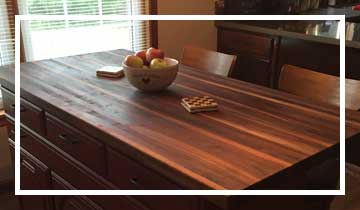How to Clean Butcher Block Countertops
To effectively clean a butcher block countertop surface, all you need is water, dish soap, microfiber cloth(s), a sponge, white vinegar, salt, and a dish towel.
If you have recently invested in a beautiful set of butcher block tops or a kitchen island, you will want to regularly maintain the warm coloration of the walnut, maple, oak, or hickory woods. Cleaning frequently helps to keep the surface looking as new as the day you purchased the countertops.
While butcher block countertops are less expensive than other countertop types such as stone, keeping the wood surface clean is key.
Use this guide to learn how to clean yohur home butcher block countertops and to prevent unwanted water/liquid damage from occurring.
Get Pricing/Place Order
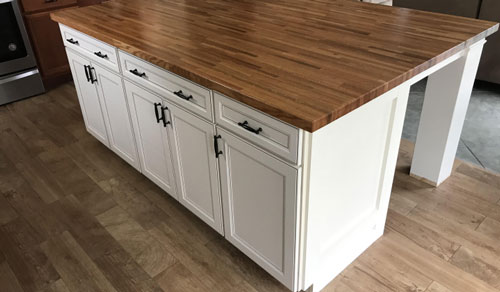

How to Clean Butcher Block Countertops: The Process
Many homeowners opt for butcher block countertops because they:
- Provide a warm, rustic look and feel to a kitchen,
- Are relatively inexpensive, and
- Are easy to maintain and clean.
With the maintenance and cleaning process being so easy, it only takes a few minutes to keep your countertops looking nice and ready for use again! Let’s get started...
What You Need to Clean Your Butcher Block
To begin cleaning your butcher block countertops, you will need the following:
- Dish soap
- Microfiber cloth(s)
- A sponge
- Fine-grit sandpaper (for stains)
- White vinegar
- Lemon juice
- Salt
- A dish towel
- Small bowl
Step 1: Scrape Off Food Residue & Scrub the Butcher Block Countertop
The first step of cleaning your butcher block countertop involves careful scrubbing of the surface:
- First, remove anything sitting on your countertops.
- Next, scrape off any food and debris that may be stuck to the surface, including caked-on dirt or crumbs. You can use a dough scraper or a spatula to work out any food. We don’t recommend using a metal scraper, as this can cause gouges and damage the wood.
- If there are still any leftover debris, you should use a microfiber cloth (or cloths) to remove any dirt or dust. Make sure the surface is clear of any remaining debris.
- You’ll now want to add several drops of dish soap to your sponge and apply to the surface of the butcher block, giving it a good scrub. Pro tip: If you scrub along the grain of the wood, it will result in a cleaner surface.
Step 2: Rinse the Surface of the Countertop
Once you have scraped and scrubbed the surface of your butcher block top, you will want to ensure it is rinsed thoroughly.
- Rinse your sponge and wipe the countertop surface a second time.
- You can also run a clean dish cloth or towel through hot water and use to rinse off the countertop.
Step 3: Remove Any Stains
If you are wondering how to clean butcher block stains, you can remove them in a couple different ways:
- If stains are present on the surface of your butcher block, you can use fine-grit sandpaper to work these out.
- Note: If the stains in your butcher block wood are from the tannins in fruits or vegetables, you can use table salt and lemon juice to help remove the stains. Simply apply the paste to the stained area, cover it with plastic wrap, and allow it to sit for between 10 and 15 minutes. After that, you can scrub the surface with a sponge to remove the stain.
Step 4: Use the White Vinegar
The next step in the cleaning process will be to apply an undiluted white vinegar wash to your countertop and allow it to dry.
- Apply the white vinegar. Start by pouring it onto a clean dish towel.
- Next, wipe the counter down to disinfect it.
- Allow the vinegar to sit for about 15 minutes. Pro tip: We recommend using vinegar because its acetic acid works to kill any bacteria embedded in the wood and sanitizes the surface.
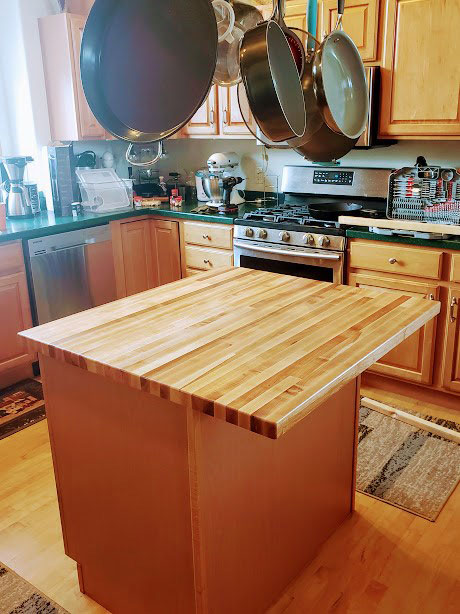
Step 5: Apply the Salt & Lemon Juice
Wondering how to clean butcher block with lemon and salt? To start, you will mix a salt and lemon juice mixture and apply it to the surface of your butcher block countertop.
- Mix 1 cup of lemon juice with a 1/2 cup of salt.
- Use your sponge to apply the lemon juice/salt mixture to your countertop. This acts as a disinfectant to help make your butcher block top more sanitary.
Step 6: Remove the Salt Mixture
If your butcher block countertop isn’t already permanently treated with a mineral oil such as Waterlox®, you should also clean your butcher block countertop using a food-safe mineral oil or a conditioner. This process will have to be repeated at least once a month.
How to Clean Butcher Block with Mineral Oil:
- If you notice that the wood is drying out, you can apply a coat of food-safe oil to the dry surface once cleaned.
- Feel free to apply as many coats as required, until the oil stays on top of the surface of the wood.
- Repeat this process monthly (or every two to four weeks, as directed by your butcher block seller’s recommendations.)
Pro tip: Ensure that the countertop is both clean and dry before applying the oil.
Step 7: Use a Microfiber Cloth to Wipe Clean
The last step of the butcher block cleaning process is to ensure everything has been wiped clean. Do this using a quality microfiber cloth.
If you have further questions about cleaning your butcher block, please don't hesitate to contact the experts at Forever Joint Tops!
Contact Us for More Info
How Often Should I Clean My Butcher Block Countertop?
We recommend that you regularly clean your butcher block countertop after every use (or daily).
Every time you cook and prepare food, you’ll want to clean it afterwards to help prevent residual food from getting stuck to the surface of the wood.
Why Butcher Block Countertops are So Easy to Clean!
Butcher block countertops have a forgiving surface. They are easy to clean since they do not require a specialized product such as a harsh chemical or cleaner. In fact, using a harsh chemical or cleaning solution may cause damage to your wood’s natural coloration or the finish.
Simply using water, dish soap, a sponge, white vinegar, salt, and a dish towel, you can clean your butcher block countertop within a few minutes.
Butcher Block vs Plastic Surfaces: Butcher Block Wins!
If you are wondering whether butcher block or plastic cutting boards are the better option, the truth is that butcher block wood features naturally occurring antimicrobial substances in its wood grain. This helps to make butcher block wood more sanitary when compared with plastic surfaces.
Get Pricing/Place Order
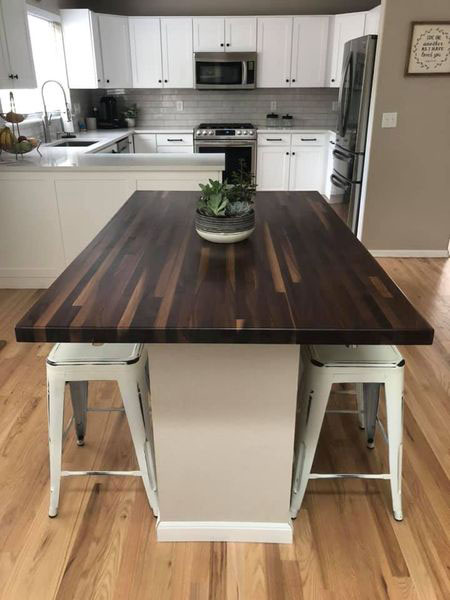
Tips for Keeping Your Butcher Block Surface Looking Great!
Butcher block may be an easy surface to clean, however, it is prone to scratches and dings. Below are some tips to ensure your butcher block stays in great shape for as long as possible:
- Don’t allow large amounts of standing water to pool on the surface of your butcher block countertop.
- Avoid chopping or cutting foods directly on your butcher block’s surface. Yes, small scratches and dings add character to the wood. However, keep in mind that scratches can also allow bacteria to fester. Try using a washable cutting board instead (for meats especially).
- DO NOT place a hot pan directly on your butcher block’s surface! Use a trivet!
- AVOID using cooking oils such as canola oil, olive oil, or corn oil to reseal your butcher block. These will become rancid over time and cause an unpleasant odor. Be sure to use a food grade oil instead.
- If you find your butcher block has plenty of scratches and dings, no worry. You can restore its appearance by sanding the surface. Pro tip: Scratches are preventable! To help avoid gouges in the wood’s surface, try using a cutting board for cutting and chopping food on instead.
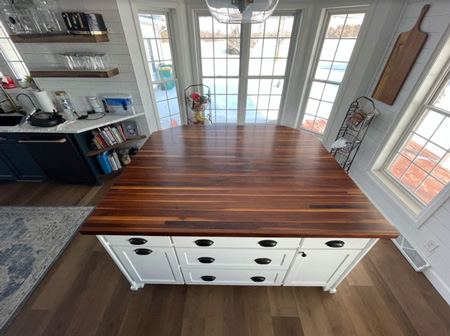
How Do I Remove Mold or Mildew?
Mold and mildew developing on your butcher block? Try using a diluted solution of chlorine bleach and water. Below are some tips for what to do:
- Start by mixing one teaspoon of bleach into a quart of water.
- Spray on the surface of the butcher block where there is mold or mildew and allow to sit for five minutes.
- Make sure you wear protective gloves!
- Wipe away the mold/mildew with a paper towel.
- Rinse the affected area with hot water and dry thoroughly.
- Repeat this process as necessary until mold/mildew is removed.
Why Choose Butcher Block Countertops?
Yes, scratches may accumulate over time and frequent oil applications may be required if the countertops aren’t permanently sealed already. However, a set of clean butcher block countertops provide several benefits for the homeowner. These include:
- Being more sustainable when compared with other countertop types,
- Having natural anti-bacterial properties,
- Being available at a wide range of prices (often much more affordable when compared with other material types),
- Having plenty of colorations and wood types to choose from,
- Complementing many styles and color schemes of kitchen, dining area, etc.
Need Help with Cleaning Your Butcher Block? Choose Forever Joint Tops!
We are the experts in crafting and cleaning butcher block surfaces! For over 50 years combined, our company has perfected our craftsmanship, to provide customers with high-quality wood and butcher-block countertops, islands, desktops, table tops, bar tops, and floating shelves.
At Forever Joint Tops, we understand that wood countertops need to be crafted with the right cuts of wood to stand the test of time. Crafted from 100% American lumber, our products are NOT a blend of face grain and edge grain. Enjoy beautiful, custom countertops crafted from walnut, hard maple, red oak, or hickory woods. Need some inspiration? Take a look at our desk ideas!
Our team focuses on “Quality that is Forever Yours.” We are a family-owned and operated company that is committed to building a long-lasting relationship with our customers. If at any time you have questions about how to clean butcher block countertops, or what you need to know before installing your butcher block, please contact us. Order your butcher block today!
Further Reading
General Butcher Block Information:
- Butcher Block Installation Guide
- Butcher Block Finishing & Care Instructions
- Butcher Block Wood Desk Ideas
- 3 Ideas for How to Enhance Your Kitchen with Butcher Block
- Pros and Cons of Butcher Block Countertops
- 7 Steps to Wood Countertop Installation
- Why You Should Choose Butcher Block for Your Next Home Project
Floating Shelves Information:
- Floating Wall Shelves: The Ultimate Buying Guide
- Butcher Block Floating Shelves Instruction Guide
- How to Style Floating Shelves in Your Kitchen
- Are Butcher Block Floating Shelves Sturdy Enough to Hold Books?
- How to Decorate Floating Shelves: Top 8 Stylish Ideas
- 15 Creative Ways to Use Your Butcher Block Floating Shelves
